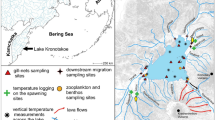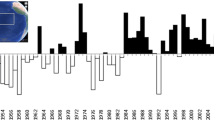Abstract
The Midas Cichlid species complex (Amphilophus spp.) in Central America serves as a prominent model system to study sympatric speciation and parallel adaptive radiation, since small arrays of equivalent ecotype morphs have evolved independently in different crater lakes. While the taxonomy and evolutionary history of the different species are well resolved, little is known about basic ecological parameters of Midas Cichlid assemblages. Here, we use a line transect survey to investigate the depth-dependent abundance of Amphilophus spp. along the shores of two Nicaraguan crater lakes, Apoyo and Xiloá. We find a considerable higher density of Midas cichlids in Lake Xiloá as compared to Lake Apoyo, especially at the shallowest depth level. This might be due to the higher eutrophication level of Lake Xiloá and associated differences in food availability, and/or the presence of a greater diversity of niches in that lake. In any case, convergent forms evolved despite noticeable differences in size, age, eutrophication level, and carrying capacity. Further, our data provide abundance and density estimates for Midas Cichlid fish, which serve as baseline for future surveys of these ecosystems and are also relevant to past and future modeling of ecological speciation.


Similar content being viewed by others
References
Arendt, J. & D. Reznick, 2008. Convergence and parallelism reconsidered: what have we learned about the genetics of adaptation? Trends in Ecology & Evolution 23: 26–32.
Barlow, G. W., 1976. The Midas cichlid in Nicaragua. In Thorson, T. B. (ed.), Investigations of the Ichthyofauna of Nicaraguan Lakes, University of Nebraska-Lincoln: 333–358.
Barluenga, M. & A. Meyer, 2004. The Midas cichlid species complex: incipient sympatric speciation in Nicaraguan cichlid fishes. Molecular Ecology 13: 2061–2076.
Barluenga, M. & A. Meyer, 2010. Phylogeography, colonization and population history of the Midas cichlid species complex (Amphilophus spp.) in the Nicaraguan crater lakes. BMC Evolutionary Biology 10: 326.
Barluenga, M., K. N. Stölting, W. Salzburger, M. Muschick & A. Meyer, 2006. Sympatric speciation in Nicaraguan Crater Lake cichlid fish. Nature 439: 719–723.
Bates, D., M. Mächler & B. Bolker, 2011. LME4: linear mixed-effects model using S4 classes. R package, v. 0.999375-40. http://cran.r-project.org.
Brakefield, P. M., 2006. Evo-devo and constraints on selection. Trends in Ecology & Evolution 21: 362–368.
Bunje, P. M., M. Barluenga & A. Meyer, 2007. Sampling genetic diversity in the sympatrically and allopatrically speciating Midas cichlid species complex over a 16 year time series. Bmc Evolutionary Biology 7: 25.
Canonico, G. C., A. Arthington, J. K. McCrary & M. L. Thieme, 2005. The effects of introduced tilapias on native biodiversity. Aquatic Conservation: Marine and Freshwater Ecosystems 15: 463–483.
Cheal, A. J. & A. A. Thompson, 1997. Comparing visual counts of coral reef fish: implications of transect width and species selection. Marine Ecology Progress Series 158: 241–248.
Elmer, K. R., H. Kusche, T. K. Lehtonen & A. Meyer, 2010. Local variation and parallel evolution: morphological and genetic diversity across a species complex of Neotropical Crater Lake cichlid fishes. Philosophical Transactions of the Royal Society London B 365: 1763–1782.
Gavrilets, S., A. Vose, M. Barluenga, W. Salzburger & A. Meyer, 2007. Case studies and mathematical models of ecological speciation. 1. Cichlids in a crater lake. Molecular Ecology 16: 2893–2909.
Gavrilets, S. & J. B. Losos, 2009. Adaptive radiation: contrasting theory with data. Science 323: 732–737.
Geiger, M. F., J. K. McCrary & U. K. Schliewen, 2010a. Not a simple case – A first comprehensive phylogenetic hypothesis for the Midas cichlid complex in Nicaragua (Teleostei: Cichlidae: Amphilophus). Molecular Phylogenetics and Evolution 56: 1011–1024.
Geiger, M. F., J. K. McCrary & J. R. Stauffer, 2010b. Description of two new species of the Midas cichlid complex (Teleostei: Cichlidae) from Lake Apoyo, Nicaragua. Proceedings of the Biological Society of Washington 123: 159–173.
Gíslason, D., M. M. Ferguson, S. Skúlason & S. S. Snorrason, 1999. Rapid and coupled phenotypic and genetic divergence in Icelandic Arctic charr (Salvelinus alpinus). Canadian Journal of Fisheries and Aquatic Sciences 56: 2229–2234.
Jennings, S. & J. Blanchard, 2004. Fish abundance with no fishing: predictions based on macroecological theory. Journal of Animal Ecology 73: 632–642.
Koch, E. W., 2001. Beyond light: physical, geological and geochemical parameters as possible submersed aquatic vegetation habitat requirements. Estuaries 24: 1–17.
Kocher, T. D., 2004. Adaptive evolution and explosive speciation: the cichlid fish model. Nature Reviews Genetics 5: 288–298.
Kullander, S. & K. E. Hartel, 1997. The systematic status of cichlid genera described by Louis Agassiz in 1859: Amphilophus, Baiodon, Hypsophyrs and Parachromis (Teleostei: Cichlidae). Ichthyological Explorations of Freshwaters 7: 193–202.
Lin, S. Y., 1961. Informe al goberino de Nicaragua sobre el desarrollo de un proyecto de pesquerías continentals en dicho país. Informe F. A. O. 1347: 1–21.
Losos, J. B., T. R. Jackman, A. Larson, K. Queiroz & L. Rodriguez-Schettino, 1998. Contingency and determinism in replicated adaptive radiations of island lizards. Science 279: 2115–2118.
McCrary, J. K., E. P. van den Berghe, K. R. McKaye & L. J. Lopez Perez, 2001. Tilapia cultivation: a threat to native species in Nicaragua. Encuentro 58: 9–19.
McKaye, K. R., J. D. Ryan, J. R. Stauffer, L. J. Lopez Perez & E. P. van den Berghe, 1995. African tilapia in Lake Nicaragua: ecosystem in transition. BioScience 45: 406–411.
McKaye, K. R., J. R. Stauffer, E. P. van den Berghe, R. Vivas, L. J. Lopez Perez, J. K. McCrary, R. Waid, A. Konings, W. J. Lee & T. D. Kocher, 2002. Behavioral, morphological and genetic evidence of divergence of the Midas Cichlid species complex in two Nicaraguan crater lakes. Cuadernos de Investigación de la UCA 12: 19–47.
Rutschmann, S., M. Matschiner, M. Damerau, M. Muschick, M. F. Lehmann, R. Hanel & W. Salzburger, 2011. Parallel ecological diversification in Antarctic notothenioid fishes as evidence for adaptive radiation. Molecular Ecology 20: 4707–4721.
Salzburger, W., 2009. The interaction of sexually and naturally selected traits in the adaptive radiations of cichlid fishes. Molecular Ecology 18: 169–185.
Schliewen, U. K., D. Tautz & S. Paabo, 1994. Sympatric speciation suggested by monophyly of crater lake cichlids. Nature 368: 629–632.
Schluter, D. & J. D. McPhail, 1992. Ecological character displacement and speciation in sticklebacks. American Naturalist 140: 85–108.
Schluter, D. & L. Nagel, 1995. Parallel speciation by natural selection. American Naturalist 140: 292–301.
Schuster, W. H., 1957. Informe al goberino de Nicaragua sobre fomento de la pesca contonental. Informe F. A. O. 607: 1–13.
Seehausen, O., 1997. Cichlid fish diversity threatened by eutrophication that curbs sexual selection. Science 277: 1808–1811.
Seehausen, O., Y. Terai, I. S. Magalhaes, K. L. Carleton, H. D. J. Mrosso, R. Miyagi, I. van der Sluijs, et al., 2008. Speciation through sensory drive in cichlid fish. Nature 455: 620–626.
Silvano, R. A. M., M. Ramires & J. Zuanon, 2009. Effects of fisheries management on fish communities in the floodplain lakes of a Brazilian Amazonian Reserve. Ecology of Freshwater Fish 18: 156–166.
Stauffer, J. R. & K. R. McKaye, 2002. Descriptions of three new species of cichlid fishes (Teleostei: Cichlidae) from Lake Xiloá, Nicaragua. Cuadernos de Investigacíon de la Universidad Centroamericana 12: 1–18.
Stauffer, J. R., J. K. McCrary & K. E. Black, 2008. Three new species of cichlid fishes (Teleostei: Cichlidae) from Lake Apoyo, Nicaragua. Proceedings of the Biological Society Washington 121: 117–129.
Streelman, J. T. & P. D. Danley, 2003. The stages of vertebrate evolutionary radiation. Trends in Ecology & Evolution 18: 126–131.
Sturmbauer, C., M. Husemann & P. D. Danley, 2011. Explosive speciaiton and adaptive radiation of East African cichlid fishes. In Zachos, F. E. & J. C. Habel (eds.), Biodiversity Hotspots: Distribution and Protection of Conservation Priority Areas. Springer: 333–362.
Sussman, D., 1985. Apoyo caldera, Nicaragua: a major quaternary silicic eruptive center. Journal of Volcanology and Geothermal Research 24: 249–282.
Thompson, A. A. & B. D. Mapstone, 1997. Observer effects and training in underwater visual surveys of reef fishes. Marine Ecology Progress Series 154: 53–63.
Waid, R. M., R. L. Raesly, K. R. McKaye & J. K. McCrary, 1999. Zoogeografía íctica de lagunas cratéricas de Nicaragua. Encuentro 51: 65–80.
Witmer, G. W., 2005. Wildlife population monitoring: some practical considerations. Wildlife Research 32: 259.
Acknowledgments
We are grateful to C. Heule, N. Hue and A. Theis for assisting us with diving; B. Christ and T. Suter for their helping hand at dive sites; the Ministerio del Ambiente y los Recursos Naturales Nicaragua (MARENA) for research permits; E. P. van den Berghe for logistical help and scientific expertise; and two anonymous referees, Associated Editor C. Sturmbauer and the Editor K. Martens for valuable comments on the manuscript; T. Roth for statistical support, and the “Fuerzas Armadas de Nicaragua” for boat cruises and air supply. This project was funded by grants from the European Research Council (ERC) and the Swiss NSF.
Author information
Authors and Affiliations
Corresponding author
Additional information
Handling editor: Christian Sturmbauer
Marie Theres Dittmann and Marius Roesti contributed equally to this study.
Electronic supplementary material
Below is the link to the electronic supplementary material.
Rights and permissions
About this article
Cite this article
Dittmann, M.T., Roesti, M., Indermaur, A. et al. Depth-dependent abundance of Midas Cichlid fish (Amphilophus spp.) in two Nicaraguan crater lakes. Hydrobiologia 686, 277–285 (2012). https://doi.org/10.1007/s10750-012-1024-1
Received:
Revised:
Accepted:
Published:
Issue Date:
DOI: https://doi.org/10.1007/s10750-012-1024-1




